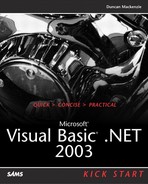Key Changes
When Visual Basic .NET was released, there were some people who considered it so different from Visual Basic 6.0 that they dubbed it “Visual Basic .NOT,” but don't let that give you an exaggerated view of the actual language changes. As a long-time Visual Basic programmer (starting with VB 3.0), I find the Visual Basic .NET language to be extremely close to Visual Basic 6.0, with a few exceptions.
The first big difference is in the use of variable types; Visual Basic .NET likes everything to be strongly typed, and although you can work around this restriction, you are better off facing the situation and going for a fully strongly typed world. Second, Visual Basic .NET is now sitting on top of the Windows .NET Framework and the Framework provides its own method for doing many of the things that VB6 already had built into its language (such as file IO). What this means is that in many cases, although the Visual Basic 6 method for accomplishing a specific task will still work, there is a new method available in the Framework.
Overall, aside from the data-typing issues, and the possible confusion between Windows .NET Framework functionality and actual Visual Basic language features, most of the changes between Visual Basic 6 and Visual Basic .NET are small details that can easily be learned. This chapter details the changes (big and small) in the language between Visual Basic .NET and Visual Basic 6, covering the new Option statements, new loop options, changes in numeric data types, and much more.
